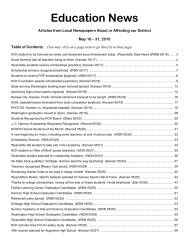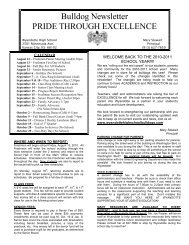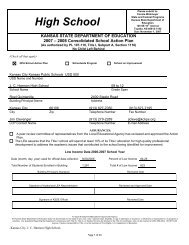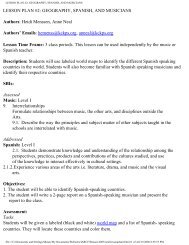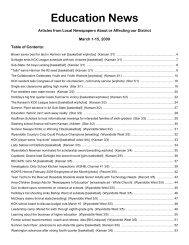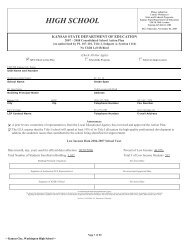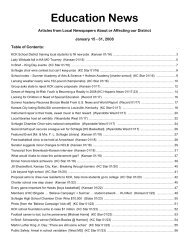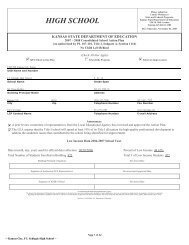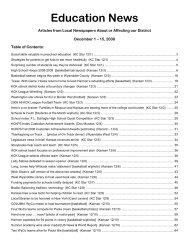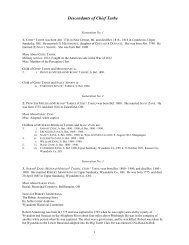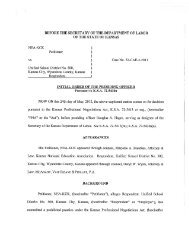Chapter V - Kansas City, Kansas Public Schools
Chapter V - Kansas City, Kansas Public Schools
Chapter V - Kansas City, Kansas Public Schools
You also want an ePaper? Increase the reach of your titles
YUMPU automatically turns print PDFs into web optimized ePapers that Google loves.
"SILVER CITY," A History of the Argentine Community of <strong>Kansas</strong> <strong>City</strong>, <strong>Kansas</strong> by Edwin Dale Shutt, II (Copyright 1976) – <strong>Chapter</strong> 5<br />
http://www.kclibrary.org/sc/post/buildings/20000308.htm<br />
<strong>Kansas</strong> <strong>City</strong>'s Convention Hall burned April 4, 1900. Within minutes the<br />
city rallied around its ashes to rebuild one of the world's largest indoor arenas in<br />
90 days, just in time to host the 1900 Democratic National Convention ...<br />
http://www.kcstar.com/millennium/part8/stories/mill8.htm<br />
The Democratic Convention was scheduled that year for <strong>Kansas</strong> <strong>City</strong> in the newly built Convention Hall.<br />
Just three months before the Convention, however, this structure burned to the ground. A ninety-day<br />
engineering feat then took place. A new hall was erected in time for the convention. Fitch’s company, the<br />
Minneapolis Steel and Machinery Company, furnished all of the steel for this project. Fitch came to <strong>Kansas</strong><br />
<strong>City</strong> and was chief engineer of the project. 5<br />
O. C. Smith’s career closely paralleled that of Fitch. Mr. Smith was born of pioneer parents in Green<br />
Bay, Wisconsin, on October 31, 1872. His family moved to St. Ansgar, Iowa, where he received his<br />
elementary and secondary education. He attended the University of Minnesota and received a degree in<br />
engineering. While at the university, he participated in all sports and was considered an outstanding baseball<br />
player.<br />
After leaving college, Smith was employed as superintendent of the Gillette-Hezog Steel Company of<br />
Minnesota. In 1900, the American Bridge Company purchased the firm and he was to remain with them until<br />
1904. Then, he accepted a position as the superintendent of the Minnesota Steel and Machinery Company. 6<br />
While working for this firm, Smith became acquainted with Fitch. They became close friends. Fitch at<br />
that time was the chief engineer of the same company. The two men decided to form their own steel company.<br />
Their first choice for a location apparently was St. Louis, Missouri. However, the Consolidated <strong>Kansas</strong> <strong>City</strong><br />
Refining Company in Argentine had just gone out of business. The land and buildings were for sale at a cheap<br />
price. 7 Furthermore, the smelter grounds were located on the Santa Fe Railroad. This site was a natural<br />
crossroads on the south side of the Kaw River about three miles from its mouth. <strong>Kansas</strong> <strong>City</strong> Structural Steel<br />
was to have frontage of 1,381 feet on the main line of the Atchison, Topeka and Santa Fe Railroad. The<br />
<strong>Kansas</strong> <strong>City</strong> Division of this railroad is a focal point onto which twelve major trunk lines coverage. 8<br />
5 <strong>Kansas</strong> <strong>City</strong> Times, November 3, 1953, p. 3<br />
6 <strong>Kansas</strong> <strong>City</strong> Star, July 4, 1936, p. 1<br />
7 Ibid, p. 2<br />
8 <strong>Kansas</strong> <strong>City</strong> Structural Steel Company, “<strong>Kansas</strong> <strong>City</strong> Structural Steel Procedure Manual,” p. 1. This pamphlet was found<br />
among the official records of the steel company.



